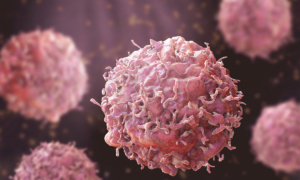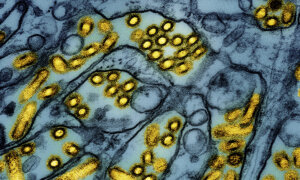Pomalidomide, a bone marrow cancer drug, may be safely repurposed to treat a rare genetic blood disorder, according to a recent clinical trial.
The Cleveland Clinic-led clinical trial was stopped early after demonstrating safety and effectiveness in treating hereditary hemorrhagic telangiectasia (HHT), a condition that currently has no cure.
Dr. Keith McCrae, professor of molecular medicine at the Cleveland Clinic who led the clinical trial, told The Epoch Times that he was motivated to find a drug for a particular patient he had 15 years ago.
“This particular client was extremely ill...was requiring tens of thousands of dollars worth of blood products every week and was essentially advised to have most of his intestine resected because he was bleeding there,” McCrae said.
McCrae dug into the research and found that the cancer drug thalidomide helped patients with similar symptoms.
“I treated him with thalidomide, and within two or three weeks, his bleeding had essentially stopped,” he said.
Thalidomide can have serious side effects. Instead of pursuing large-scale research with thalidomide, McCrae used another cancer drug with a similar chemical structure called pomalidomide.
The study, published in the New England Journal of Medicine, assigned adults with HHT in a 2:1 ratio to receive either pomalidomide or a placebo for 24 weeks. The trial was planned to run for four years but was stopped at 24 weeks after a second analysis showed that pomalidomide had met the threshold for efficacy.
An Often Overlooked Disease
Like many genetic disorders, HHT is often underdiagnosed. The disease affects around 1 in 5,000 people and is the second most common inherited blood disorder.
Also known as Osler-Weber-Rendu syndrome, HHT causes blood vessels to become abnormally twisted and tangled. Blood vessel abnormalities appear as red and purple spidery spots on the face, around the lips, inside the mouth and nasal cavities. They are often fragile and burst, leading to random recurring bleeding, making nosebleeds a hallmark sign of the condition.
HHT can also cause arteriovenous malformations (AVMs), which are tangled blood vessel connections in the brain, lungs, and liver, which may rupture unexpectedly—leading to life-threatening complications like stroke and lung bleeds. People with HHT may have a shorter lifespan than the general population.
Sarrah Hein wasn’t aware of HHT until she was diagnosed at 26 while pregnant with her son, Anthony, who was also diagnosed with the condition.
“Looking back, I had many of the signs and symptoms of HHT growing up. I had nosebleeds often, a large AVM (blood vessel tangles) in my lung, which made it harder to keep up with my classmates during cross-country practice, and I had low iron,” she told The Epoch Times.
She inherited HHT from her father.
Francesca, a 26-year-old from Italy, is waiting for her HHT diagnosis to come in a month.
“I have frequent nosebleeds since I was a child, even at night. There are weeks when my nose bleeds every day. My mother also has this problem,” she shared with The Epoch Times. However, like many others with HHT, nosebleeds were just the tip of the problem.
In October 2021, after an emergency room visit for a migraine with aura, doctors ran several tests after finding that her lungs sounded like there was “something” there. They found tangled blood vessel formations in the lungs, which were causing her to have low blood oxygen.
Francesca’s main symptom was fatigue after physical exertion. “I couldn’t walk up a flight of stairs without being out of breath. Running was out of the question. Walking uphill was very tiring for me,” she said. In February, she had an embolization too close to the two largest blood vessel tangles, or AVMs.
Prior to this, Francesca had no idea about HHT. “It was one of the surgeons who did my embolization who suggested that I might have it,” she stated. “Knowing that I was getting tired easily because of the AVMs and not because I was lazy was liberating ... on the other hand, it is scary enough to know that AVMs could pop up in my brain or anywhere.”
Though Francesca was not formally diagnosed, her geneticist said that HHT is highly likely, given her constellation of symptoms.
Hein’s son Anthony had AVMs in his brain, which caused abnormal blood flow in his brain.
As a result, for many years, Hein’s paid time off was spent taking Anthony to medical appointments and preparing for surgery, which harmed her social life and mental health, she said. Anthony is now excelling in college, and she is now able to focus on improving her lifestyle through exercising, eating whole foods, and increasing social interactions, which helps her control her work stress and keep her disease at a minimum.
Looking ahead, Hein hopes for an oral medication that can reduce AVMs in the future.
Pomalidomide As Long-Term Treatment
Pomalidomide, which is taken orally, may be Hein’s hope come true.
Managing HHT focuses on preventing nosebleeds by using blood thinners and more aggressive approaches, such as ablating abnormal vessels or surgically closing the nostrils. Severe cases may require regular iron or blood transfusions to treat anemia.
Participants who took pomalidomide at 4 milligrams (mg) daily in the trial had a sustained reduction in nosebleed severity, improved red blood cell and hemoglobin levels, and a better quality of life.
Researchers speculate that pomalidomide works by stopping the growth of abnormal blood vessels. “We do think that this drug does induce changes in the blood vessels themselves,” McCrae said. However, he added that actual tissue studies are needed to prove that.
Other therapies that work similarly to pomalidomide include the cancer drug bevacizumab. This drug targets VEGF (vascular endothelial growth factor), a protein that promotes blood vessel formation. However, the researchers said that pomalidomide may be more convenient as it can be taken orally.
Pomalidomide remained effective even at lower doses of 2 and 3 mg, which may reduce side effects.
Though the researchers did not follow participants after the trial ended, McCrae said that some patients remained in remission for three to four months after stopping the drug.
However, the dosing used in the study may have been too high, with researchers speculating that the 4 mg daily dose may have suppressed bone marrow, limiting hemoglobin production. “I’m treating a couple of patients off study now with lower doses, and their hemoglobin levels are quite normal,” McCrae said.
He hopes to identify the right dosage for long-term treatment.
Mild side effects were seen, including low white blood cell count. However, this was reversible with dose reduction or discontinuation. Other side effects included constipation and rash.
Severe and potentially life-threatening adverse events were rare but more common in the pomalidomide group.
Around a quarter of people in the pomalidomide withdrew during the trial, with 16 percent of those withdrawing because of adverse events, while 10 percent in the placebo group withdrew for other reasons. Neuropathy and platelet deficiency were also reported.
For some patients, the effects of the drug have been life-changing. One patient couldn’t run or go on trips to Florida and snorkel with his children because his nose would bleed, “but now he can do that.” McCrae said.
McCrae hopes that the drug will be more accessible in clinical practice. “These days, there are many things that we think can help patients that we really aren’t able to use because of difficulty in having them covered by insurers. And these medications are not inexpensive.”
He added that publishing the study will provide rigorous evidence of its efficacy, which he hopes will “lower the bar for getting insurance approval for those physicians and patients who want to try this because there are no FDA-approved drugs at all for this disease.”














